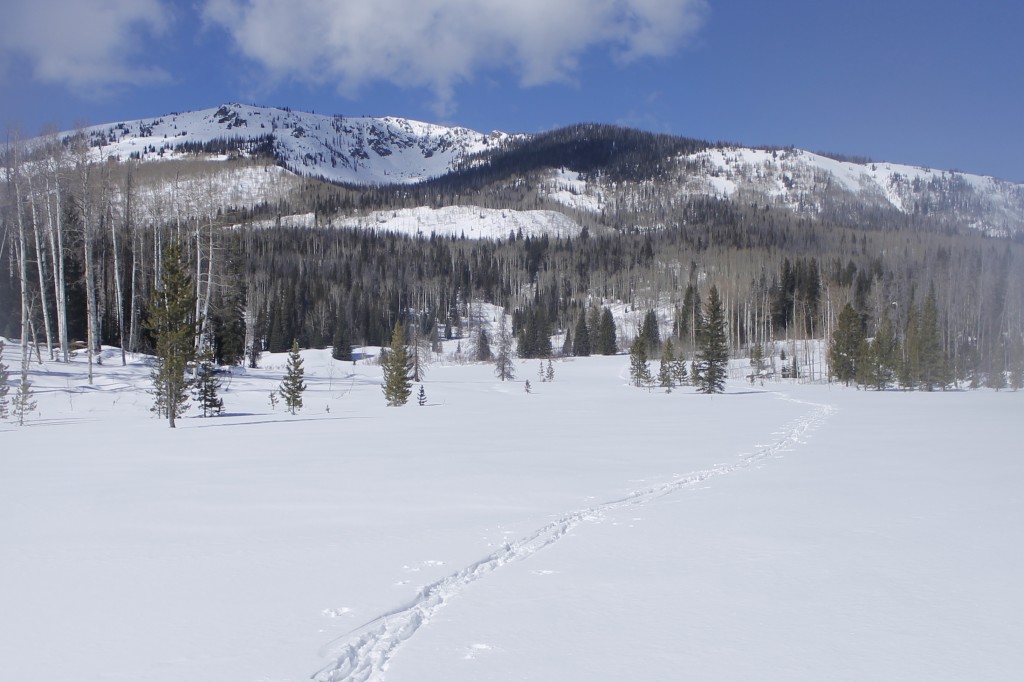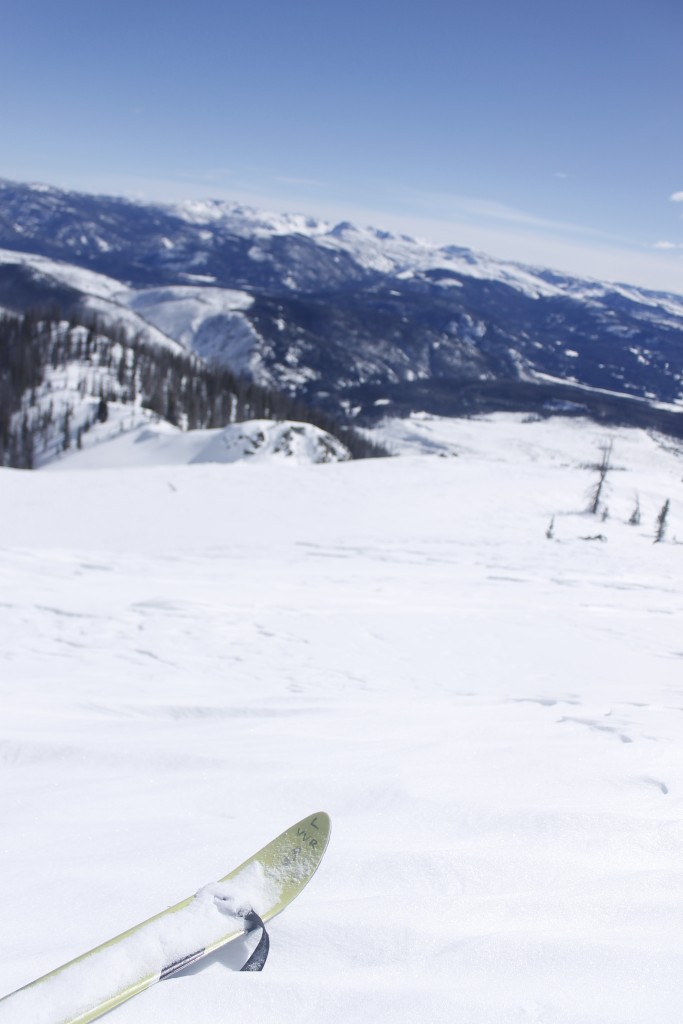
On crust and on slush
“To hell with it,” I announced, clicking out of my ski bindings so that I could kick up the icy slope in boots.
I had just started the trip, but was already fed up with the skis chittering every which way and the strain of setting the edges into snow crust so that they didn’t slip. The time and energy it took to fight the crust was taking away from the effort I’d need to spend in the miles ahead. So why not try to turn that crust to my advantage by just walking up it?
As soon as I put my boots on the snow, I found that I could get uphill easily. The crust held me above the snow as I beat a straight line up the ridge, skis cradled in my arms.
It’s a good thing I’m not a purist about staying in the bindings. Taking on the hill this way was much faster — even faster than when I was skiing with climbing skins.
The changing nature of the snow beneath my feet was a key player in deciding whether my all-day trip from doorstep (7,800 feet) to the top of Farwell Mountain (10,800 feet and about five miles of skiing distant) would be success or failure. Now that we were getting warm weather, the south slopes of the mountains were getting mushy beneath the afternoon sun, only to become tilted ice rinks at night when the cold temperatures refroze the snow. With the new day, the sun would work its magic again, and much like a tub of ice cream left outside the freezer, the crust would soften up, sometimes to the point of gloppification, whereupon it would stick to the ski bottoms.
Within this cycle was a theoretical sweet spot, a time when the snow would have perfect softness for skiing down, not too hard, not sticky mush. I hoped the time would be right when I started back down the mountain and that the snow would yield to the ski edges like ice cream to a spoon. If the window opened for a few hours in the afternoon, I’d have one chance to carve through softened snow without accelerating to terrifying speeds. The window would start to close even before the sun set. Once the sun was low enough in the sky, it would lose the power to hold back the cold below, and the cold would turn the surface back to ice.
Ski boots can walk too

I gave myself a hard turn-around time: 2 p.m. If I didn’t start heading back by then, I figured, I would likely end up skiing on ice slopes.
I chastised myself for taking a 7:30 breakfast and not hitting the trail until 8. Probably, I wasn’t going to make it. The last time I’d tried a day trip to Farwell, I had started half an hour earlier and had been somewhere on the summit ridge when 2 p.m. rolled around, but it wasn’t the top.
Of course, white-out conditions had complicated navigation on that trip. The falling powder also made me slower going uphill, but it had also given me fairly good control going back down.
Now I puffed to the top of the ridge where I promptly fell through the crust to my knees.
I tried jogging a couple more steps and fell through a couple more times.
OK, time to put skis back on.
I skimmed up a more mild incline, along the rim of the col where I had my igloo, still standing nearly two months after I finished building it. The summit of Big Agnes glimmered in the far distance. Until we meet again, my friend.
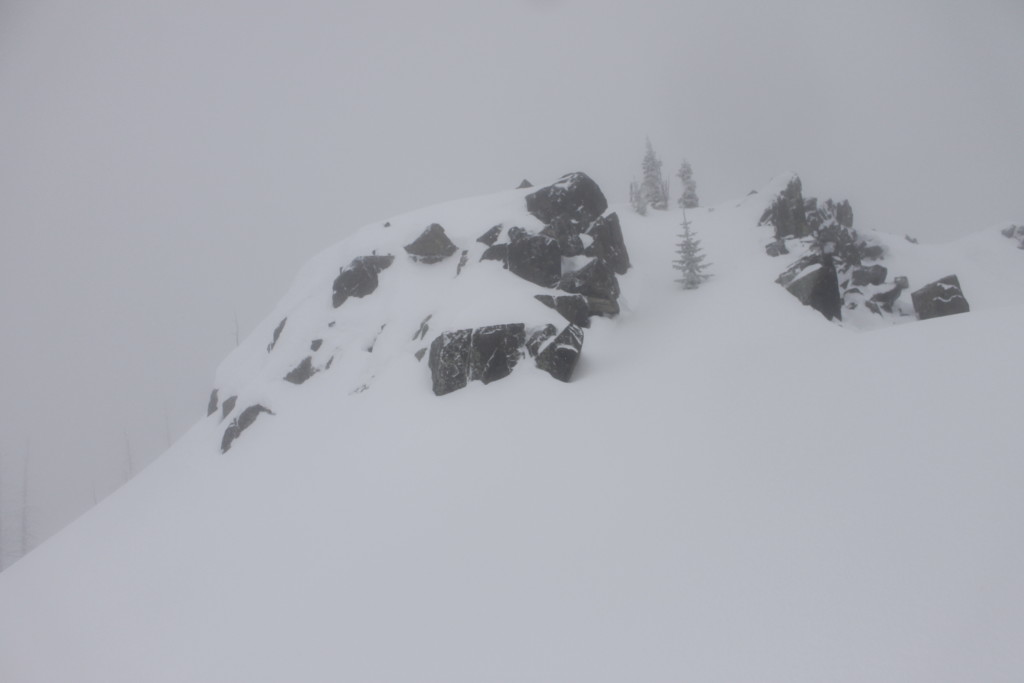
A heavy windstorm earlier in the month had knocked down several of the beetle-killed lodgepole pines, creating new obstacles for me to navigate. Detouring past one of these deadfalls took me down a wimpy slope that was still so icy that I almost fell face first. At a second ridge, I decided to try climbing in my boots again. Sure enough, the slope was rock-solid and easy to climb without post-holing. The extra-tilt had probably made the difference, since it meant that the winter sun would hit the snow at a right angle, creating more melt followed by more ice.
When I got to the top of this ridge, I put the skis back on and started going hard, following the ghost of my old tracks for a while, then cutting further west to try a new (I hoped) more gradual climb up the mountain.
I left my climbing skins on as I followed the ridge, to a third uphill section. This time, I climbed the hill in my skis. I could already feel the snow softening. It was getting warm out. When I got to a flat section, I went ahead and peeled off the skins along with a light jacket I’d been wearing.
Nordic rhythm
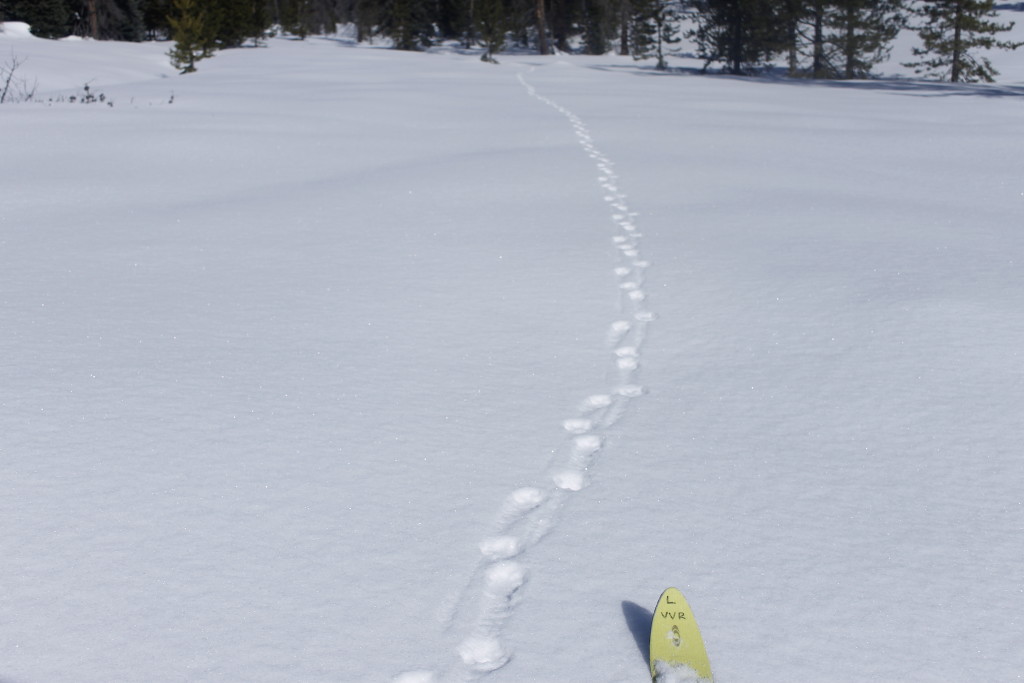
The backcountry Nordic skis on my feet were light and narrow enough so that I could maintain a decent stride and glide to eat up distance quickly. While not as light and delicate as track skis meant exclusively for groomed trail. These are not the skis most people would use on a mountain like Farwell. I knew good and well that if I would be hard-pressed to make them turn if I took them down an aggressive pitch.
Moreover, their free-heel bindings, connecting them to the boot via a single metal bar, are far more fragile than the clunky Tranformer-esque downhill ski boots and bindings designed to carve the gnar. The soft boots would not withstand the kind of torsion forces that a recreational downhill skier would put in on a lift-operated hill. There was higher risk of broken ski or broken skier.
With that in mind, a typical backcountry skier going out in short, heavy boards and monstro boots would have eaten my snow dust trying to catch me on the flats.
Daring downhill descents may get more GoPro coverage, but there is an equally worthy, if more subtle challenge for those who want to cover ground in cross country skis with efficiency and body awareness.
I concentrated on kicking hard off the back ski, letting it float into the air behind me, then bringing it back down to the snow tip to tail.The goal was to balance on one moving ski at a time— maximum thrust, minimum friction, minimum superfluous body movement. If I did well, my reward was a steady whooosh-click with poles and skis. I changed the rhythm to match the terrain, but there was always rhythm. If I got off kilter for a moment, or lost concentration, I felt my speed suffer and the rhythm disappear. It was jarring, like playing music off a scratched disk.
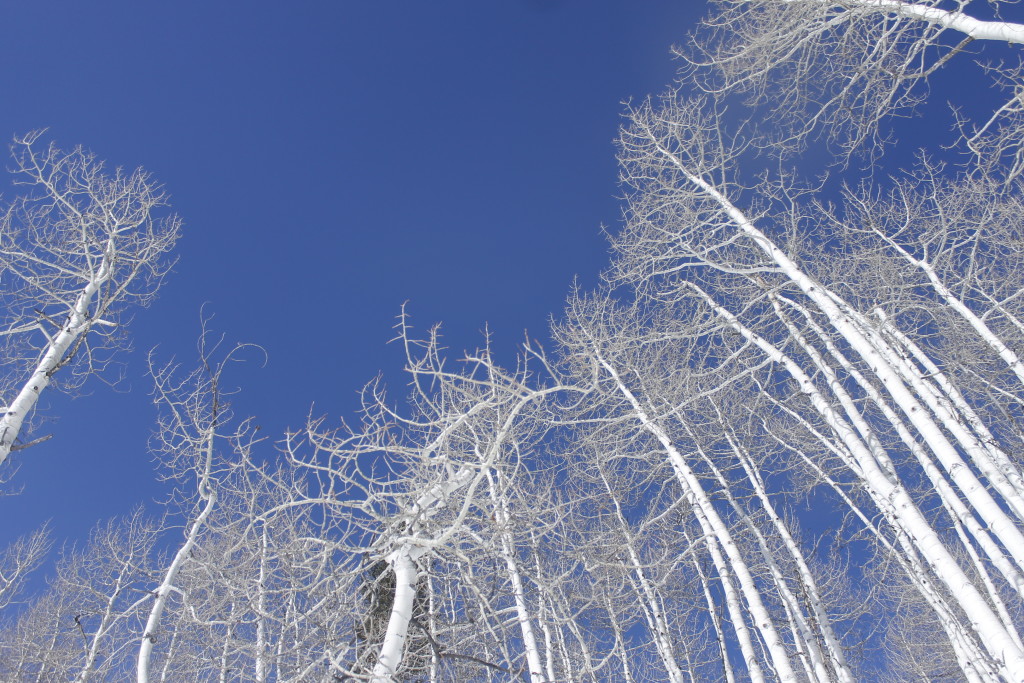
I hit pause as I came out of the trees to look at the mountain in my path. Farwell rose to the north, a 2,000-foot wall of snow, trees and rock. A massive bowl, ripe with avalanche potential lay dead center. On my earlier trip, I’d skinned up the trees on the east side of the bowl until the going had gotten steep enough for me to switch to snowshoes for the final push to the summit ridge. Here, I’d met fierce winds and whipping snow. Half an hour of snow globe climbing brought me to a rock outcrop, where I couldn’t see anything higher than I was (though I couldn’t really see more than 200 yards at this point.) I decided that though this probably wasn’t the summit, it was a great place to turn around.
Now, looking at the mountain again, I was convinced that my original plan, to go to the west of the bowl was the best way. This route would take me up through a steep aspen forest and to a ridge where I could (hopefully) skin up to the summit and then ski back down the same way. It was longer than my failed route, but I figured that I could make better time if I stayed in my skis. I didn’t even bring snowshoes this time.
Before I started climbing, I had to ski downhill into a basin. The slope here was north-facing, so it had powder instead of crust, but it was still fast snow.
I carved out a couple of telemark turns through a grove of pine saplings, and then realized that I was heading for a sunken log at high speed. I sailed over, picking up air, before landing in a lunge in a small drainage gully.
I pumped my fist in the air.
“Whooo! That’s what I’m talking about!” I shouted to the trees and squirrels.
Who knew if I would make the top today? I was glad I’d come out.
Skinning Farwell
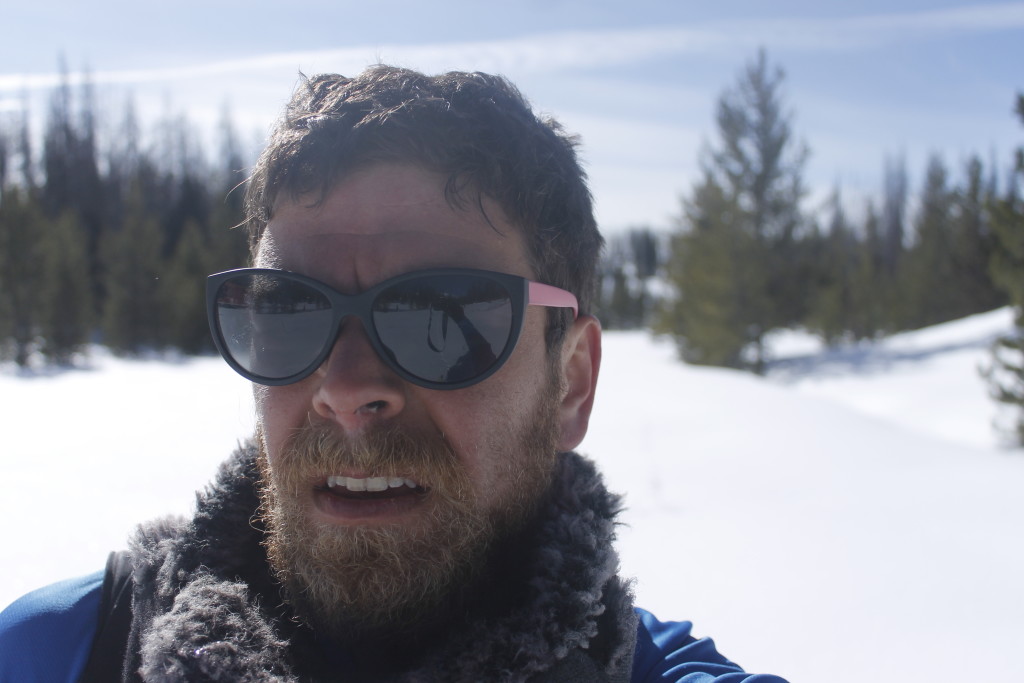
Back on crusty snow in the drainage, I resumed skiing up a slight incline, following some fox tracks. The sky was deep blue, cut with pearl-white aspen boughs. A deep ravine loomed up in my path. Instead of losing elevation by going down it, I stayed patient and followed it uphill to the east until it receded into the mountain. I took a break to eat and drink, then put skins on my skis. I’d brought two pairs for the occasion so that I could cover almost the entire ski bottoms with the strips of synthetic hair. The hairs lie at an angle so that the ski slides going uphill, but resist sliding backward. This friction, would allow me to power up steep pitches that would have been impossible otherwise.
Even with skins, the climb would take a lot from me. I began making switchbacks that required wobbly kick turns with the skis. Soon my heart was pounding and a sweat zone was spreading between my pack and spine.
How easy to forget — even when there is a direct way up, even when there are no boulders to scale or avalanche zones to bisect — climbing the side of a mountain is hard.
Switchback after switchback, I watched the land drop away, revealing the Pearl Lake Reservoir, Hole In The Wall Canyon and the Colton Creek drainage. The tooth of Hahns Peak rose to the west. It had been too long since I’d climbed a real mountain. It is a fine way to take a new view of the world. Part of climbing’s thrill, is that it gives you the opportunity to imagine that you have transcended the paltry concerns of the world below. This isn’t true, but the perspective is refreshing and leaves the door open for other subversive thoughts. When I look out from high, it reminds me what a vast space we live in, and how much life and possibility exist to fill it.
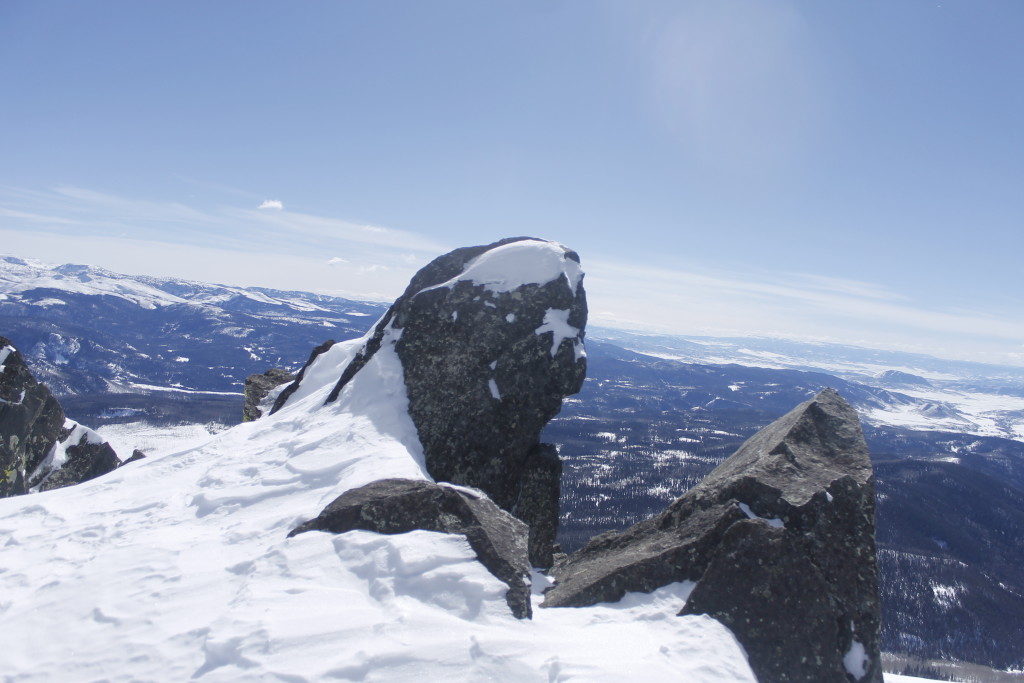
The view up the mountain was less encouraging. The ridge I was aiming for seemed to get further back the more I climbed. I bargained with myself that it might be easier to take a more middle path up the mountain, closer to the bowl, even though this might mean steeper terrain, possibly greater avalanche risk (though unlikely in the old, compacted snow.)
The aspens thinned as I climbed, then gave way to dispersed evergreen groves. I noticed long stretches running down the slope, where nothing grew. That was where the avalanches had been, I thought, where they could happen again. A slip there on the hard-pan snow could mean a long, ugly fall. I did my best to avoid these places.
As in my earlier hike up Big Agnes, I stayed in trees as much as possible, or lined myself up beneath boulders as I climbed. Still, there were moments where I would ski out above one of these big empty corridors, anxiety welling in my gut, before I got back into the cover of some pines.
I found one area of disturbed snow, that I thought for sure had been the site of a slide. I looked closer and realized that I was looking at snowmobile tracks. The fact that noisy engines had barreled straight up the treeless pitch without triggering anything reassured me that the snow was stable, though I also wondered if the drivers had even considered the risk.
I got back into the cover of some pines, tackling trickier and tricker switchbacks with the skis. The snow up here had hardly softened a whit in the full sun, ski edges could barely scratch them.
Nearing the top of the ridge, I took the skis off again and started kicking up the slope.

Within a quarter mile, I was on the ridge, which was a quick ski away from the summit.
The exposure and the altitude gave the top of Farwell the grizzled alpine quality I love about mountain tops: gnarled trees, jagged boulders stripped bare by the elements. Hard winds had carved the snow into scale-like sastrugi, beautiful repeating shapes that were the music between the mountain and the wind — improvisational, yet rhythmic patterns riffing within some divine free jazz masterpiece.
Amidst this, stood an improbable wall of solar panels, antennae and a corrugated metal transmitter station, surrounded by snowmobile tracks. The panels, like the mountain face I had just climbed, were tilted at an extreme angle to maximize the sun’s input. Cell phone conversations and high definition television were no doubt passing through my body from the dish nearby. I wondered if there would be a place where I could eat lunch inside, or even grab a beer, but the lonely outpost offered no such accommodations.
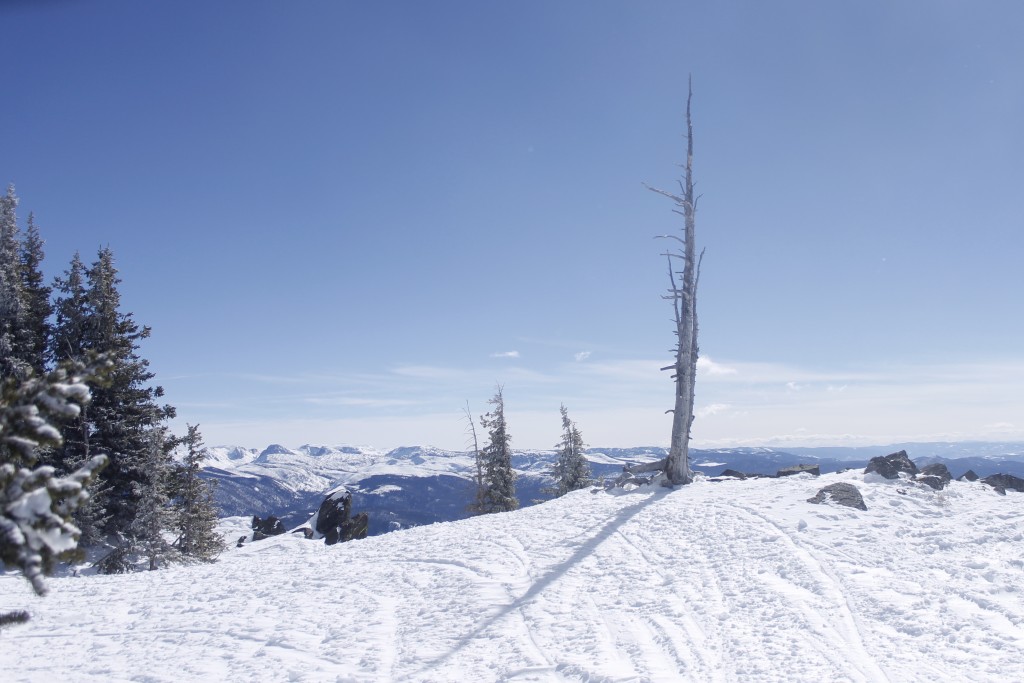
Just as well. I skied over to a high ledge looking out over the valley I’d just climbed out of. The view was worth suffering a little wind. The stark plains of Wyoming lay to the north. I scanned east over the Zirkel Range, recognizing the snowfield that I’d taken (almost) to the top of Big Agnes. Was there any other way I could have climbed that mountain? None of the other routes I could see looked possible or free from serious avalanche risk and this made me feel a little better for not standing on the exact top of that mountain.
Going down slow, going down fast
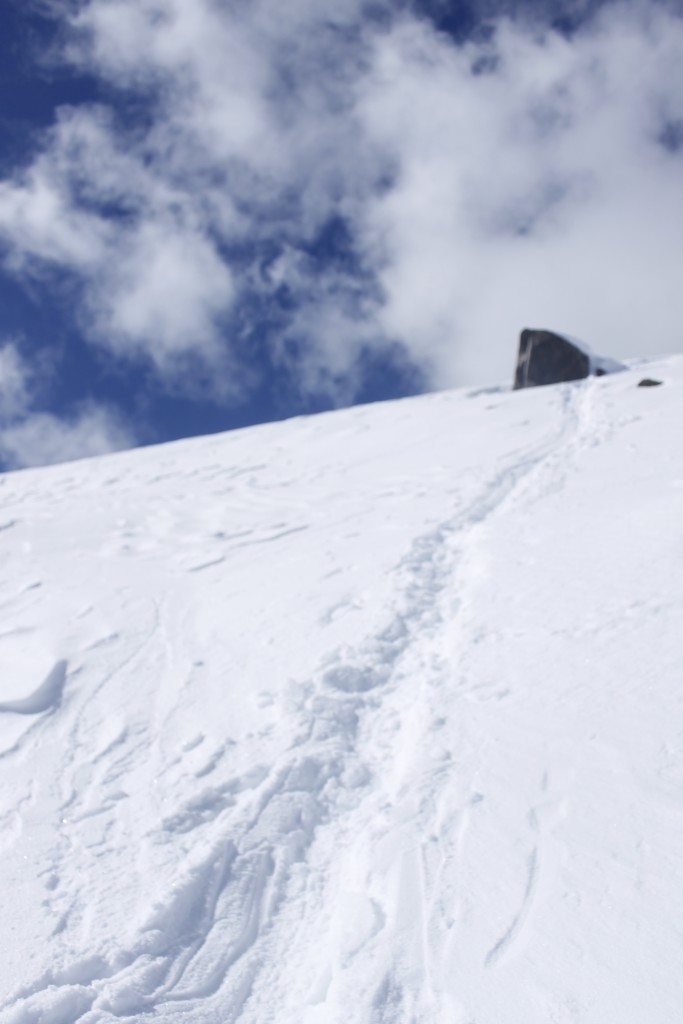
A more immediate concern was how I would get down off the mountain I was standing on now. It was about 12:45, well before my mandatory turnaround time. The hardpan snow that I had just climbed made me a little iffy about the ski down. If I went that way, I would take skis off and glissade (slide on my butt) over the steepest sections, then keep my skins on the skis so that I wouldn’t build up more momentum than I wanted.
If I took another tack, I could follow the summit ridge line east, and come down the way I’d gone on my last trip. If I could stay north of the ridge for a while, I would have a bit of powder to ski instead of hardpan. I scanned my surroundings for a while and double-checked my map, then decided that this was the way to go.
Leaving the skins on the skis for the descent felt awkward and jerky at times, but it did allow me to take on slopes that I wouldn’t have dared to try otherwise. Skiing in slo-mo, I cut bold lines down a small bowl, made a quick glissade down the steepest section, got back into my skis for a pretty fast set of turns through some trees.
The powder on the shadowed north face of the ridge was more enjoyable to ski than the ice snow and I felt good control in the skins. Unfortunately, the way back meant going south, and that meant I needed to take on the ice slopes at some point.
I followed the ridge through thick pine forest, then climbed back onto the south side where the aspens grew. Here, the snow had finally begun to soften. The pitch was still way too steep for me to ditch the skins in the skis that I had, so I contented myself with long traverses. In any case, I was making better time than I would if I were in snowshoes.
I swooped down to the top of a drainage and saw ghost tracks in the snow. A familiar-looking pine tree reminded me that this had been the exact spot where I had put my skis on when I’d been going down the mountain on my previous trip. This, I figured, was as good a place as any to ditch the skins and ski all out.
The crust was mostly melted now, which meant that I could carve, but I would still be moving above an icy layer, and moving fast — much faster than I had gone through the powder on the earlier trip.
I pointed the skis along the old tracks and started flying. Though I barely turned down the hill, it felt like I had rockets at the ends of my skis. I used the telemark position to absorb the shock of bumps, and to desperately turn into the hill to cut speed. I would come to a stop, adrenaline pumping, kick turn and fly down in the opposite direction.
I dropped into the drainage where the pitch began to get milder. I could see a couple of crisp turns in my old tracks and decided try and match them. Bad idea. I went ass over teakettle, landing hard. I felt a sharp pain in my hip and got up immediately before it could decide to be a serious injury. I was still miles from any help and it was a bad place to fuck up.
I started skiing again, more cautiously. I did get in a few turns I was proud of as the pitch mellowed. I also lost my balance a couple times. Finally, I spilled out at the base of a willow drainage at the base of the mountain.
There was a pine tree plantation to ski through, that afforded an impressive view of what I’d just climbed, the snow faces reflecting mid-afternoon sun.
I knew I hadn’t done anything too incredible in terms of skiing prowess, but the skis were a means to getting to the summit and getting back down. I was proud that I hadn’t felt the need to leave them on at all times. Nor was I ashamed that I had left the skins on the skis for the descent, because that had allowed me to use the light, narrow skis that minimized my approach time.
Now that I was heading back, I shed the downhill mentality and got back to thinking like a Nordic skier, searching for the rhythm that I needed to power over the flats. There would be the final set of ridges to come down before I got home and I wanted to get to them before the sun got low in the sky. I could feel the snow consolidate as the cold began to freeze the surface back to ice.
The window was closing. It looked like I’d make it through just in time.
